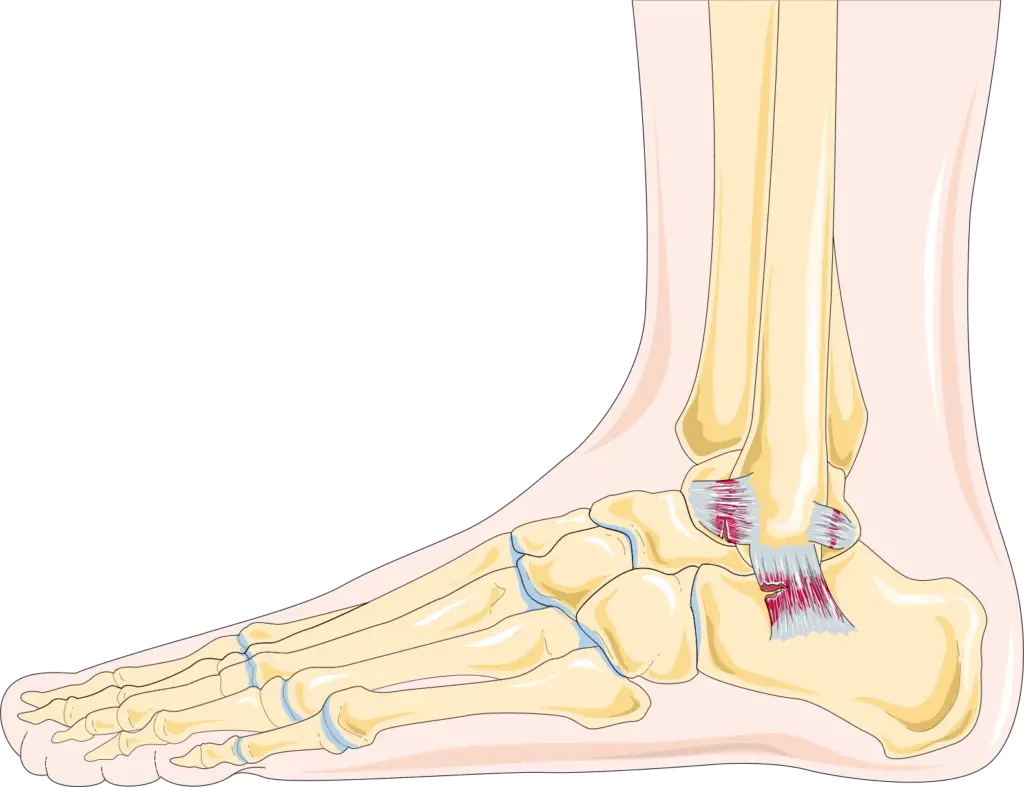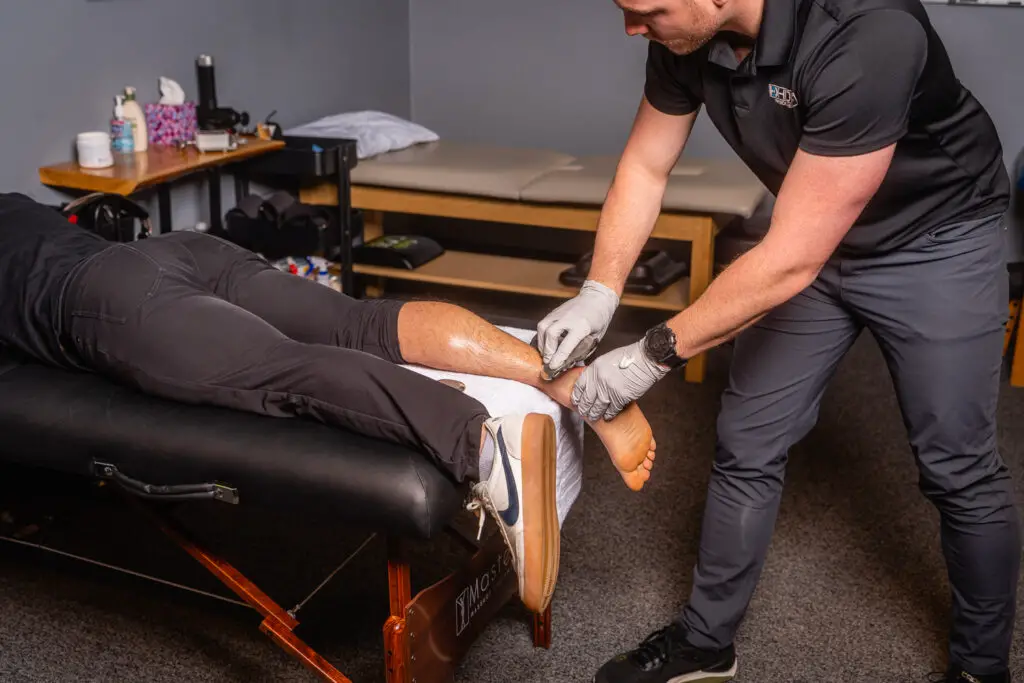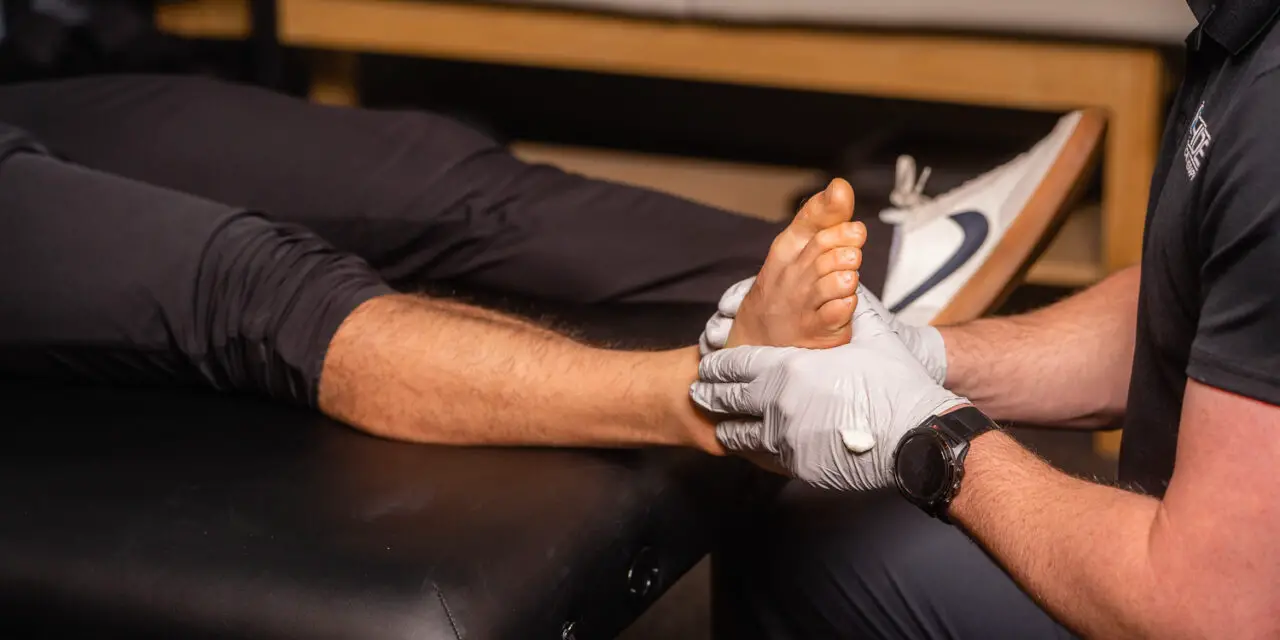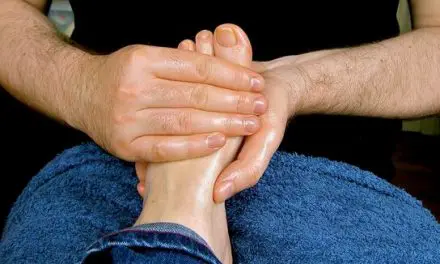When you twist or roll your ankle, it can cause sudden and intense pain. This could be either a sprain, which is an injury to the ligaments that support the joint, or a break (or a fracture), which is an injury to the nearby bone.
Both often cause swelling, bruising, and pain. Fractures are often accompanied with intense pain with any weight bearing or pressure. A fracture may also look deformed or have an obvious bump or indentation on the skin. And so, here’s how to tell the differences so you can seek the right medical attention.

(Ankle ligament sprain. Image by Laboratoires Servier distributed under the Creative Commons Attribution-Share Alike 3.0 Unported license.)
Why is a sprain more painful than a fracture?
Sprains are typically more painful than fractures, even though many assume the latter to be worse since a break seems more severe. To understand why this is, consider what happens when a sprain or fracture occurs and how the body responds to each injury.
A sprain is an injury that affects the ligaments when they are stretched beyond their normal limitations, like a rubber band stretched to the brink of breaking. This causes inflammation and swelling of all the tissues in the joint, which may cause further pain due to the increase in pressure.
The pain felt from fractures, however, would be more painful with weight bearing. They can range from simple hairline cracks to complete breaks and are often accompanied by pain, swelling, bruising, and sometimes visible deformity at the injury site.
“And if the fracture is bad enough, weight bearing will not be possible without severe pain,” said Dr. Zach Smith, who is a physical therapist and co-owner of HIDEF Physical Therapy in Seattle, Washington. Depending on where the break is located, there may also be nerve damage that exacerbates pain and discomfort.

Physical therapist Zach Smith of HIDEF Bellevue Physical Therapy examines a patient’s ankle to see if it is sprained or broken. (Photo courtesy of Zach Smith, photo by Eric Hutchinson of Dreamlapse Studios)
The extent of the pain felt often depends on the severity of the fracture or sprain. For example, in a survey conducted of more than 2,000 ankle injuries it was found that more severe swelling and an inability to put any weight on the site are common with fractures, whereas strains typically have less swelling and have more ability to bear weight.
In cases where there are fractures, surgery may be necessary to realign the bones correctly and restore stability of the joint. Fractures and sprains are both injuries that involve damage to a part of the body and can cause pain; however, the extent of pain felt and type of treatment needed may differ depending on which injury has occurred.
Can a sprain turn into a fracture?
It’s possible for a sprain to turn into a fracture, however, it seems to be uncommon. To see how this can be possible, we need to understand how our body reacts to an injury.
Bones and soft tissues have a symbiotic relationship: bones give us rigidity while the soft tissue gives us movement. Together they give us stability, but our bodies are masters at compensating.
When something isn’t working right, sometimes we can’t tell when our own movements or posture have changed. This kind of inherent ability helps us move in ways that don’t cause pain, but it can also lead to subtle problems that can snowball over time. Knowing this we can see how a sprain may lead to a break.
According to the American Orthopaedic Foot and Ankle Society (AOFAS), sprains are more prevalent than fractures in ankle injuries but if a sprain is severe enough it can weaken both the bones and ligaments of the joint resulting in a fracture. This can occur if there is a tear in the ligaments in the event of a severe sprain. The tissues weaken and are unable to bear the force applied, leading to a fracture.
Common symptoms to watch out for include:
- swelling
- pain
- tenderness
- bruising
- decreased range of motion
- deformity or instability in the joint
- difficulty walking
Related: [Sprain vs fracture: how to tell the difference]
Treatment for a spain vs. a fracture
Treatment for ankle fractures depends on the severity of the injury. In mild cases, immobilization with a cast or brace may be all that is needed to allow healing, but a medical professional is the only one who can diagnose you.
When asked how patients are evaluated, Dr. Smith replied, “The best way to rule out a fracture is an X-ray. These are usually a lot faster to get and less expensive. If the X-ray does not show a fracture your doctor may recommend an MRI. This MRI would be able to evaluate ligament sprains and could determine the severity of that injury. The MRI is also more detailed to pick up a smaller fracture.”
Also, keep an eye out for any changes in pain level or new symptoms, such as swelling, redness, pus, and fever as these are signs of infection.
Research shows risk factors for ankle fractures include:
- age
- previous injury or fracture
- certain medical conditions that weaken bones, such as osteoporosis, poor nutrition, and high-impact activities (e.g. running).
These risk factors may influence the treatment a doctor or physical therapist chooses to use. A study conducted with the aid of multiple agencies in Australia found that stress fractures are more common among adolescents who participate in sports which require a great deal of strain on the affected areas. This indicates that repeated sprains or strains can cause damage to the bones and lead to fractures over time. As a result, medical professionals are more likely to use more permanent braces, such as casts, on teenagers.
To minimize the risk of serious fractures, The American Academy of Orthopaedic Surgeons (AAOS) recommends that people of all ages take part in regular physical activity, such as walking, to strengthen the joint as a whole and help prevent occurrence of fractures—especially those of the ankles.
Should I see a doctor?
Always seek out a medical professional for any sprain. Even if your pain is not severe or you believe the injury has healed, medical advice can help provide insight into potential long-term consequences of an ankle sprain or strain.
For example, should you have a slight misalignment in your ankle due to repeated sprains and strains, it may be possible to correct this with regular stretching and exercise.
In addition to diagnosis and treatment, your doctor may recommend a brace or splint to help support the ankle during physical activity, as well as steps to reduce the risk of reinjury. When asked about the RICE method (rest, ice, compression, and elevation), Dr. Smith replied, “The RICE method is slightly outdated but portions of it can still be helpful for pain relief.”

Physical therapist Zach Smith of HIDEF Bellevue Physical Therapy examines a patient’s ankle to see if it is sprained or broken. (Photo courtesy of Zach Smith, photo by Eric Hutchinson of Dreamlapse Studios)
Other methods of pain relief can be used, such as topical pain ointments. Dr. Smith has observed that these are entirely based on personal preferences. Some people prefer to use creams and salves with natural ingredients, while others find that over-the-counter products work better for them. But Smith specified to “avoid creams that cause skin irritation as the benefit of the cream [will not] outweigh the negative side effects in this case.”
Lastly, a full recovery may take several weeks or months, depending on the severity of the injury. Only a medical professional can properly diagnose and provide treatment advice on your specific case.
“Bracing until you know what type of injury you have and can get the opinion of a medical professional,” Dr. Smith said. “This helps you to avoid further injury. We also know that the faster you get a diagnosis and treatment, the better the outcome so make sure to see a doctor or physical therapist as soon as possible.”
Related: [Medial ankle anatomy and injuries]

Lindsay Jones, LMT
Lindsay is a licensed massage therapist and a mother of three, who specializes in rehabilitation with emphasis on prenatal and postnatal care.
After graduating from the National Holistic Institute in San Jose, Calif., she went on to study how pain affects the body and how it can be alleviated during the constant changes of pregnancy and early motherhood.
In her free time, Lindsay has a deep love of all forms of art from storytelling and music to sewing and painting.






